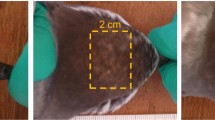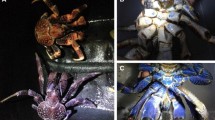Abstract
Carotenoid- and melanin-based colors are valuable indicators of quality in many vertebrates, but their signaling role in invertebrates remains relatively unexplored. The Asian ladybird beetle Harmonia axyridis is an ideal organism for studies of this nature because males and females exhibit highly variable red and black colors on their elytra and are chemically defended with an alkaloid (harmonine). We used digital photography to quantify elytra coloration and absorbance spectrophotometry and gas chromatography mass spectrometry analyses to quantify pigment and alkaloid concentrations, respectively, in wild-caught male and female H. axyridis. We predicted that extensive or intense coloration would be an aposematic signal of high-alkaloid stores. We found that carotenoid pigments largely controlled variation in red elytra coloration. There was no relationship between alkaloid content and either elytra redness or carotenoid pigment concentration in either sex. However, we found a positive correlation between the extent of elytra coloration and alkaloid content. Animals with proportionally more red (or less black) on the elytra were more alkaloid-rich; this relationship was particularly strong in females. We also found that females with lighter black spots had greater amounts of harmonine than those with darker spots. These results suggest that elytra color patterns have the potential to reveal information about chemical defensiveness to mates or predators. Prior studies in this species show that nonmelanic forms are typically less active and yet more sexually attractive than melanic forms, and both results may be explained by the fact that nonmelanics are better chemically defended.




Similar content being viewed by others
References
Brakefield PM, Wilmer PG (1985) The basis of thermal melanism in the ladybird Adalia bipunctata: differences in reflectance and thermal properties between the morphs. Heredity 54:273–277
Britton G, Goodwin TW, Harriman GE, Lockley WJ (1977a) Carotenoids of the ladybird beetle, Coccinella septempunctata. Insect Biochem 7:337–345
Britton G, Lockley WJ, Harriman GA, Goodwin TW (1977b) Pigmentation of the ladybird beetle Coccinella septempunctata by carotenoids not of plant origin. Nature 266:49–50
Dale J (2000) Ornamental plumage does not signal male quality of red-billed queleas. Proc R Soc Lond B 267:2143–2149
Edmunds M (1974) Defence in animals. Longman, New York
Enders D, Bartzen D (1991) Enantioselective total synthesis of harmonine, a defence alkaloid of ladybugs (Coleoptera: Coccinellidae). Liebigs Annalen der Chemie 6:659–674
Fox DL (1976) Animal biochromes and structural colors. University of California Press, Berkeley, CA
Fox HM, Vevers G (1960) The nature of animal colors. Macmillan, New York
Frazer JFD, Rothschild J (1962) Defence mechanisms in warningly-coloured moths and other insects. Int Cong Ent 11:249–256
Goodwin TW (1984) The biochemistry of carotenoids, vol II. Animals. Chapman & Hall, New York
Grether GF, Hudon J, Millie DF (1999) Carotenoid limitation of sexual coloration along an environmental gradient in guppies. Proc R Soc Lond B 266:1317–1322
Grether GF, Hudon J, Endler JA (2001) Carotenoid scarcity, synthetic pteridine pigments and the evolution of sexual coloration in guppies (Poecilia reticulata). Proc R Soc Lond B 268:1245–1253
Grether GF, Cummings ME, Hudon J (2005) Countergradient variation in the sexual coloration of guppies (Poecilia reticulata): drosopterin synthesis balances carotenoid availability. Evolution 59:175–188
Griffith SC, Parker TH, Olson VA (2006) Melanin- versus carotenoid-based signals: is the difference really so black and red? Anim Behav 71:749–763
Grill CP, Moore AJ (1998) Effects of a larval antipredator response and larval diet on adult phenotype in an aposematic ladybird beetle. Oecologia 114:274–282
Grill CP, Moore AJ, Brodie ED III (1997) The genetics of phenotypic plasticity in a colonizing population of the ladybird beetle, Harmonia axyridis. Heredity 78:261–269
Hill GE (1999) Mate choice, male quality, and carotenoid-based plumage coloration. Proc Int Ornithol Congr 22:1654–1668
Hill GE (2002) A red bird in a brown bag: the function and evolution of ornamental plumage coloration in the house finch. Oxford University Press, Oxford
Hill GE (2006) Female mate choice for ornamental coloration. In: Hill GE, McGraw KJ (eds) Bird coloration. II. Function and evolution. Harvard University Press, Cambridge, MA, pp 137–200
Hill GE, McGraw KJ (2006) Bird coloration, vol II. Function and evolution. Harvard University Press, Cambridge, MA
Hill GE, Montgomerie R (1994) Plumage colour signals nutritional condition in the house finch. Proc R Soc Lond B 258:47–52
Hill GE, Inouye CY, Montgomerie R (2002) Dietary carotenoids predict plumage coloration in wild house finches. Proc R Soc Lond B 262:1119–1124
Jennions MD (1998) Tibial coloration, fluctuating asymmetry and female choice behaviour in the damselfly Platycypha caligata. Anim Behav 55:1517–1528
Joop G, Mitschke A, Rolff J, Siva-Jothy MT (2006) Immune function and parasite resistance in male and polymorphic female Coenagrion puella. BMC Evol Biol 6:19
Koch RL (2003) The multicolored Asian lady beetle Harmonia axyridis: A review of its biology, uses in biological control, and non-target impacts. J Insect Sci 3:1–16
Lin JT, Wu CY (1992) A comparative study on the color vision of 4 coleopteran insects. Bull Inst Zool Acad Sin 31:81–88
McGraw KJ (2006a) The mechanics of carotenoid coloration in birds. In: Hill GE, McGraw KJ (eds) Bird coloration. I. Mechanisms and measurements. Harvard University Press, Cambridge, MA, pp 177–242
McGraw KJ (2006b) The mechanics of melanin coloration in birds. In: Hill GE, McGraw KJ (eds) Bird coloration. I. Mechanisms and measurements. Harvard University Press, Cambridge, MA, pp 243–294
McGraw KJ, Ardia DR (2003) Carotenoids, immunocompetence, and the information content of sexual colors: an experimental test. Am Nat 162:704–712
McGraw KJ, Hill GE (2000) Differential effects of endoparasitism on the expression of carotenoid- and melanin-based ornamental coloration. Proc R Soc Lond B 267:1525–1532
McGraw KJ, Wakamatsu K (2004) Melanin basis of ornamental feather colors in male zebra finches. Condor 106:686–690
McGraw KJ, Mackillop EA, Dale J, Hauber ME (2002) Different colors reveal different information: how nutritional stress affects the expression of melanin- and structurally based ornamental coloration. J Exp Biol 205:3747–3755
McGraw KJ, Gregory AJ, Parker RS, Adkins-Regan E (2003) Diet, plasma carotenoids and sexual coloration in the zebra finch (Taeniopygia guttata). Auk 120:400–410
McGraw KJ, Hudon J, Hill GE, Parker RS (2005a) A simple and inexpensive chemical test for behavioral ecologists to determine the presence of carotenoid pigments in animal tissues. Behav Ecol Sociobiol 57:391–397
McGraw KJ, Hill GE, Parker RS (2005b) The physiological costs of being colorful: nutritional control of carotenoid utilization in the American goldfinch, Carduelis tristis. Anim Behav 69:653–660
Møller AP, Biard C, Blount JD, Houston DC, Ninni P, Saino N, Surai PF (2000) Carotenoid-dependent signals: indicators of foraging efficiency, immunocompetence, or detoxification ability? Avian Poult Biol Rev 11:137–159
Needham AE (1974) The significance of zoochromes. Springer-Verlag, New York
Nijhout HF (1991) The Development and evolution of butterfly wing patterns. Smithsonian Institution Press, Washington, DC
Oliphant LW, Hudon J (1993) Pteridines as reflecting pigments and components of reflecting organelles in vertebrates. Pigment Cell Res 1:129–131
Olson VA, Owens IPF (1998) Costly sexual signals: are carotenoids rare, risky or required? Trends Ecol Evol 13:510–514
Osawa N, Nishida T (1992) Seasonal variation in elytral colour polymorphism in Harmonia axyridis (the ladybird beetle): the role of non-random mating. Heredity 69:297–307
Pfleiderer W (1992) Pteridines: properties, reactivities and biological significance. J Heterocycl Chem 29:583–605
Pfleiderer W (1994) Nature pteridine pigments-pigments found in butterflies wings and insect eyes. Chimia 48:488–489
Rowell-Rahier M, Pasteels JM (1986) Economics of chemical defense in Chrysomelinae. J Chem Ecol 12:1189–1203
Rutowski RL, Macedonia JM, Morehouse N, Taylor-Taft L (2005) Pterin pigments amplify iridescent ultraviolet signal in males of the orange sulphur butterfly, Colias eurytheme. Proc R Soc Lond B 272:2329–2335
Senar JC, Figuerola J, Domenech J (2003) Carotenoid but not melanin-based plumage ornamentation is related to nutritional condition in the Great tit Parus major. Naturwissenschaften 90:234–237
Skelhorn J, Rowe C (2006) Avian predators taste-reject aposematic prey on their level of chemical defence. Biology Letters 2:348–350
Stewart LA, Dixon AFG (1989) Why big species of ladybird beetles are not melanic. Funct Ecol 3:165–177
Stoehr AM (2006) Costly melanin ornaments: the importance of taxon? Funct Ecol 20:276–281
Talloen W, Van Dyck H, Lens L (2004) The cost of melanization: butterfly wing coloration under environmental stress. Evolution 58:360–366
Vershinin A (1999) Biological functions of carotenoids—diversity and evolution. Biofactors 10:99–104
Vukusic P, Sambles JR (2003) Photonic structures in biology. Nature 424:852–855
Acknowledgments
We thank J. Bezzerides for animal care, F. Schroeder for providing a sample of harmonine, and two anonymous referees for valuable comments on the manuscript. Data collection for this project was supported by the Cornell chapter of Sigma Xi (Grant-in-Aid-of-Research to Bezzerides) and the Environmental Protection Agency (graduate STAR fellowship to McGraw). Funding during manuscript preparation was provided by the University of Wisconsin-Colleges (to Bezzerides) and the College of Liberal Arts and Sciences and the School of Life Sciences at Arizona State University (to McGraw). All experiments described in this study comply with the current federal laws of the USA.
Author information
Authors and Affiliations
Corresponding author
Additional information
Communicated by I. Cuthill
Rights and permissions
About this article
Cite this article
Bezzerides, A.L., McGraw, K.J., Parker, R.S. et al. Elytra color as a signal of chemical defense in the Asian ladybird beetle Harmonia axyridis . Behav Ecol Sociobiol 61, 1401–1408 (2007). https://doi.org/10.1007/s00265-007-0371-9
Received:
Revised:
Accepted:
Published:
Issue Date:
DOI: https://doi.org/10.1007/s00265-007-0371-9




